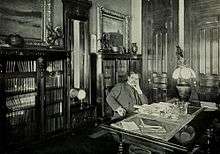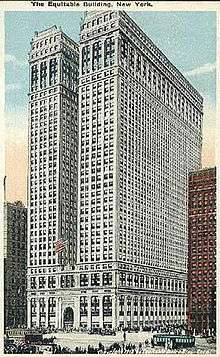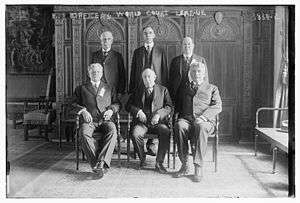Emerson McMillin
Emerson McMillin (April 16, 1844 - May 30, 1922) was an American financier and banker. The head of the banking house of Emerson McMillin, McMillin won a commission through "gallant conduct under fire" fighting for the Union Army in the Civil War, before moving to the Ohio Valley to work in the iron works and steel industries.[1] He founded American Light and Traction in 1900 and became president.[2][3]
Emerson McMillin | |
|---|---|
 | |
| Born | April 16, 1844 |
| Died | May 30, 1922 |
| Nationality | American |
| Occupation | Head of Emerson McMillin bank |
Early life
He was born on April 16, 1844 in Ewington, Ohio.[1] His family was of Scottish heritage, and had initially settled in Virginia. He was the twelfth of fourteen children, and went to school several months a year until the age of ten.[3] His father was the manager of an iron furnace and Emerson worked as an iron furnace apprentice for four years starting at age 12, in 1856.[1] He acquired a good education with hard study after-hours, with a particular interest in scientific research. The Times wrote that he "made a practice of thoroughly examining the application of the scientific principles of the iron and gas industries."[1]
Career
Military activity
Devoutly anti-slavery unlike his father, he attempted to sign up for the American Civil War at the age of seventeen. Rejected for his age, when he turned 18 he signed up for the 18th Ohio.[3] He served in the Union Army starting in 1862. He was wounded three times in the war,[1] while other sources say he was wounded five times. He served in 38 battles. In the war, McMillin and his brothers were known as the "fighting McMillins,"[3] Of his five brothers, three were killed in the conflict. McMillin himself won a commission through "gallant conduct under fire."[1]
Business

He worked for ten years in the Ohio Valley in iron works and steel mills.[1] In Ohio, he became manager or president of several institutions, and afterwards focused his energies on gas properties and their consolidation and growth.[1] In 1891, he started a commercial bank involved in mergers and acquisitions in the industry. The Times wrotes that the bank's focus was "of a sort then rather new in banking circles," because of its focus on the purchase and merging of gas interests. He believed in consolidating competitors as a business strategy, for example causing the merger in St. Louis of four gas companies, increasing their net profit significantly.[1]
Among his other positions, he was president of the Columbus Street Railway Company in Columbus, Ohio, where he lived for some time. After having moved to New York City, he resigned as president on April 14, 1898 due to a "diversity of business connections in other localities," although he retained other interests in Columbus, including gas interests.[4] He founded the American Light and Traction in 1900[2] for the purpose for consolidating the utility industry's small, local power suppliers,[5] and also became president.[2][3] By 1901, American Light and Traction owned and controlled over 40 gas producing plants, electric light and traction (streetcar) properties.[6]
In 1922, although he had experienced two years of poor health, he remained head of the banking house of Emerson McMillin Co. at 120 Broadway, chairman of the American Light and Traction Company, and president of "a dozen other lighting and traction concerns throughout the country."[1]
Philanthropy and civic efforts

He supported a number of civic projects with his own funds, for example the Arbitration Society of the Americas to allow for the arbitration of civic disputes outside a court.[1] He served as president of the organization.[1] In 1915, he was at the first meeting of the World's Court League, and was appointed vice president. McMillin provided initial funding in 1916 for the founding of Columbia Business School in New York.[7][8]
Personal life
McMillin married Isabel Morgan and she died after his death in 1922. They had four children: Marion McMillin, Estelle McMillin Traverso, Maud McMillin, Emerson McMillin II.[1]
Following George Crocker's death in 1909, McMillin bought his 1907 home, the Crocker Mansion, a 45,000 square feet house at Mahwah, New Jersey, designed by the architect James Brite.[9] He was an art collector of "unusual discernment," and Thomas E. Kirby described McMillin's painting collection sold in January 1913 as the finest collection of American and foreign pictures ever sold in the United States. At the 1913 sale, his Orpheus and Eurydice by Jean-Baptiste-Camille Corot was sold for $75,200.[1]
McMillin died of pneumonia on May 30, 1922 in Mahwah, New Jersey.[1] In late October 1924, the furnishings from the Crocker-McMillin mansion were auctioned, with profits reaching $185,000 on the third day of sales. Among the items were rare paintings and rugs.[10] His grandson, Emerson McMillin 3d, died in New York at the age of 41 in 1935, and was survived by his mother Baroness Traverso of Florence, Italy, and his wife Olga Kohler McMillin of the Hotel St. Regis.[11]
See also
- List of bank mergers
- McMillin Observatory
- Crocker-McMillin Mansion
References
- "Emerson M'Millin Dies of Pneumonia. Banker Fails to Rally From Brief Attack After Two Years of Ill-Health. His Work In Arbitration. Society He Founded for Civic Disputes Mourns Death. Gained Fame as Art Collector". New York Times. June 2, 1922. Retrieved 2015-03-17.
- "MyDTE Energy - About us - MichCon - The early 1900s". Retrieved 2006-09-06.
- Goodrich, Arthur (September 1901). "A Leader Of Modern Industry". The World's Work. New York, NY: Doubleday, Page & Co. II (5): 1201–1208. Retrieved April 29, 2012.
- "Emerson McMillin Resigns". The New York Times. April 15, 1898. Retrieved April 25, 2017.
- ""Simple Choices" - How Much Will They Cost You?". Archived from the original on 7 October 2006. Retrieved 2006-09-06.
- "Emerson McMillin" (PDF). Archived (PDF) from the original on 8 September 2006. Retrieved 2006-09-06.
- "Archived copy". Archived from the original on 2015-05-02. Retrieved 2015-04-08.CS1 maint: archived copy as title (link)
- Metre, Thurman William Van (1954). "A History of the Graduate School of Business, Columbia University".
- http://www.nj.com/news/index.ssf/2008/09/crocker_mansion_in_mahwah_sell.html
- "Sales at Darlington Now Total $185,000; Rare Rugs and Paintings of the McMillin Collection Were Disposed Of Yesterday". The New York Times. October 30, 1924. Retrieved April 24, 2017.
- "Emerson McMillin 3D; Grandson of Capitalist and Art Collector Served in World War I". The New York Times. December 30, 1935.
Further reading
| Wikimedia Commons has media related to Emerson McMillin. |
- "Emerson M'Millin Dies of Pneumonia. Banker Fails to Rally From Brief Attack After Two Years of Ill-Health. His Work In Arbitration. Society He Founded for Civic Disputes Mourns Death. Gained Fame as Art Collector" (PDF). New York Times. June 2, 1922.
- Goodrich, Arthur (September 1901). "A Leader Of Modern Industry". The World's Work. New York, NY: Doubleday, Page & Co. II (5): 1201–1208.